Around Belfast
I stayed at the Linen House Hostel in central Belfast. So central, in fact, that I was right, smack dab in the centre of the city. If you’ve never stayed in a hostel before, you may be wondering what exactly one is. Basically, a hostel is a place with beds. Lots of beds. If you’re interested in fancy, luxury accommodations like, say, double beds, room service, and hot water, a hostel may not be what you’re looking for. But, if you don’t mind staying in a room with 21 other people, you might try a hostel. (Plus, it’s cheap…really cheap…but you get what you pay for,)

The hostel is officially in what is called the Cathedral Quarter.

(If you click the map, you will get a really huge file.)
The hostel isn’t shown in this map (which is a pottery art fixture hanging on the side of a building) but it would be where the compass rose is.
The Cathedral Quarter gets its name from the Cathedral Church of St. Anne, just a couple blocks from the hostel. This cathedral is part of the Church of Ireland – the Irish flavour of the Anglican Church.

There are more pictures of this cathedral in the post about St. Anne’s.
Just next to the cathedral are three large buoys, actual buoys used near Belfast and placed here to commemorate the city’s naval heritage.

Not too far away (and in the upper right corner of the map above) is the Albert Clocktower.

Begun in 1865, the clocktower was recently restored since the wooden foundations were rotting away and the tower was in danger of falling over. Of course, the dangerous leaning was nothing new. As early as 1879, the tower began having bits lopped off to keep it from falling totally over. Since the restoration, the tower still leans noticeably but, supposedly, won’t lean any further.

If you stand in front of the tower and turn left, you see Cave Hill and the outline of a sleeping giant. It is said that the giant’s profile is what gave Jonathan Swift the inspiration to write Gulliver’s Travels.

Just past the tower is McHugh’s, a pub established in 1711. The white part of the building is Belfast’s oldest surviving building.

Just across from McHugh’s is the Custom House, built between 1854 and 1857.

The open expanse of paving is quite popular with local skateboarders.
Not much further on is this large fish.

The guidebook I have calls it ‘Big Fish’ and says it’s the work of Belfast sculptor John Kindness.
Big Fish is located next to the Lagan River.

This weir was build recently to hold back the tidal flow of the Lagan and therefore keeping the ‘great banks of fetid mud from being exposed twice daily.’

If you go a bit further up the Lagan to the next bridge…

…you see this large wire woman in Thanksgiving Square.

From the plaque nearby:
Walking back along the river, you can see some interesting buildings…

…and these two cranes in the dockyards where the Titanic was built (although these cranes are a bit newer).
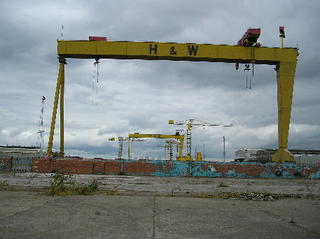
They’re not just any cranes, though. These are Sampson and Goliath, the second and third largest cranes in the world.
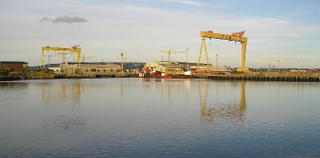
At a height of 140 meters, these cranes could each lift 840 tons. In this picture, look along the bottom until you see the four cables hanging down out of the picture. Now, look just a bit to the left at the little part hanging down from the small yellow bit. This is where the crane operator sat.

These cranes have recently been given a historical designation and will be staying put for quite a while.

Now, let’s head back to the Albert Clocktower and down through this tunnel to the other side of the street.

Heading toward the centre of the city, there are a number of shopping opportunities and some interesting buildings.


Even the local Tesco grocery store is in an interesting building.



In fact, with it’s shops and tourist busses…
 …Belfast appears to be a normal, plain ol’ city.
…Belfast appears to be a normal, plain ol’ city.
Until you see a police car, that is.

Nearby is the Northern Bank building where, on December 19, 2004, masked robbers ended up stealing more than £26 million.

I also saw the Europa Hotel, known to the Guinness record people as the most bombed hotel in the world. It’s also known as the hotel where the Clintons (Bill and Hillary) stayed on their historic visit to Belfast.


Next to the Europa Hotel is the Grand Opera House.
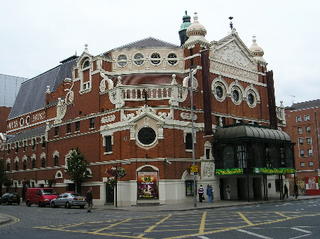
I took a tour and they’re right…it is pretty grand!
One evening as I was searching for food (well, looking for a restaurant…it’s not like I was scavenging in gutters or anything), I saw this sign.

Further out from the centre of the city is Stormont, the site of the parliament of Northern Ireland. It was opened in 1932 and was a gift from England following the partition of Ireland.

Although the building is closed to visitors, we were able to stop in front of the building and check out it’s snazzy driveway.

On the afternoon I took a rather apprehensive stroll through West Belfast (more on that later), I saw several other churches.
St. Patrick’s was completed in 1877.
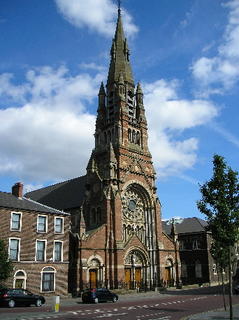
St. Peter’s was built in 1866 but did not become an official Catholic cathedral until 1986. It is rather nifty, though.

The two towers were added in 1876.

And check out the organ pipes. They really are painted like that.

I also stopped into the Church of the Holy Redeemer (also Clonard Monastery) where some initial, top-secret talks were held leading to the 1994 IRA cease-fire.


Also on my stroll of uneasiness, I passed the Royal Victoria Hospital. I can’t vouch for their medical prowess, but they do have a rather nice fence. It’s supposed to resemble DNA (according to my guidebook) and has the letters X and Y along the top and bottom.




The hostel is officially in what is called the Cathedral Quarter.

(If you click the map, you will get a really huge file.)
The hostel isn’t shown in this map (which is a pottery art fixture hanging on the side of a building) but it would be where the compass rose is.
The Cathedral Quarter gets its name from the Cathedral Church of St. Anne, just a couple blocks from the hostel. This cathedral is part of the Church of Ireland – the Irish flavour of the Anglican Church.

There are more pictures of this cathedral in the post about St. Anne’s.
Just next to the cathedral are three large buoys, actual buoys used near Belfast and placed here to commemorate the city’s naval heritage.

Not too far away (and in the upper right corner of the map above) is the Albert Clocktower.

Begun in 1865, the clocktower was recently restored since the wooden foundations were rotting away and the tower was in danger of falling over. Of course, the dangerous leaning was nothing new. As early as 1879, the tower began having bits lopped off to keep it from falling totally over. Since the restoration, the tower still leans noticeably but, supposedly, won’t lean any further.

If you stand in front of the tower and turn left, you see Cave Hill and the outline of a sleeping giant. It is said that the giant’s profile is what gave Jonathan Swift the inspiration to write Gulliver’s Travels.

Just past the tower is McHugh’s, a pub established in 1711. The white part of the building is Belfast’s oldest surviving building.

Just across from McHugh’s is the Custom House, built between 1854 and 1857.

The open expanse of paving is quite popular with local skateboarders.
Not much further on is this large fish.

The guidebook I have calls it ‘Big Fish’ and says it’s the work of Belfast sculptor John Kindness.
Big Fish is located next to the Lagan River.

This weir was build recently to hold back the tidal flow of the Lagan and therefore keeping the ‘great banks of fetid mud from being exposed twice daily.’

If you go a bit further up the Lagan to the next bridge…

…you see this large wire woman in Thanksgiving Square.

From the plaque nearby:
‘This female figure represents various allegorical themes associated with hope and aspiration, peace and reconciliation and is derived from images derived from Classical and Celtic mythology. Her position on the globe signifies a unified approach to life on this earth. It encompasses oneness, while celebrating the diversity of culture that exists in our global village.’
Walking back along the river, you can see some interesting buildings…

…and these two cranes in the dockyards where the Titanic was built (although these cranes are a bit newer).

They’re not just any cranes, though. These are Sampson and Goliath, the second and third largest cranes in the world.

At a height of 140 meters, these cranes could each lift 840 tons. In this picture, look along the bottom until you see the four cables hanging down out of the picture. Now, look just a bit to the left at the little part hanging down from the small yellow bit. This is where the crane operator sat.

These cranes have recently been given a historical designation and will be staying put for quite a while.

Now, let’s head back to the Albert Clocktower and down through this tunnel to the other side of the street.

Heading toward the centre of the city, there are a number of shopping opportunities and some interesting buildings.


Even the local Tesco grocery store is in an interesting building.



In fact, with it’s shops and tourist busses…
 …Belfast appears to be a normal, plain ol’ city.
…Belfast appears to be a normal, plain ol’ city. Until you see a police car, that is.

Nearby is the Northern Bank building where, on December 19, 2004, masked robbers ended up stealing more than £26 million.

I also saw the Europa Hotel, known to the Guinness record people as the most bombed hotel in the world. It’s also known as the hotel where the Clintons (Bill and Hillary) stayed on their historic visit to Belfast.


Next to the Europa Hotel is the Grand Opera House.

I took a tour and they’re right…it is pretty grand!
One evening as I was searching for food (well, looking for a restaurant…it’s not like I was scavenging in gutters or anything), I saw this sign.

Further out from the centre of the city is Stormont, the site of the parliament of Northern Ireland. It was opened in 1932 and was a gift from England following the partition of Ireland.

Although the building is closed to visitors, we were able to stop in front of the building and check out it’s snazzy driveway.

On the afternoon I took a rather apprehensive stroll through West Belfast (more on that later), I saw several other churches.
St. Patrick’s was completed in 1877.

St. Peter’s was built in 1866 but did not become an official Catholic cathedral until 1986. It is rather nifty, though.

The two towers were added in 1876.

And check out the organ pipes. They really are painted like that.

I also stopped into the Church of the Holy Redeemer (also Clonard Monastery) where some initial, top-secret talks were held leading to the 1994 IRA cease-fire.


Also on my stroll of uneasiness, I passed the Royal Victoria Hospital. I can’t vouch for their medical prowess, but they do have a rather nice fence. It’s supposed to resemble DNA (according to my guidebook) and has the letters X and Y along the top and bottom.



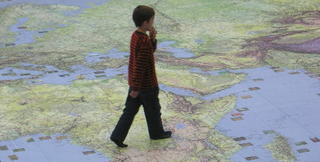



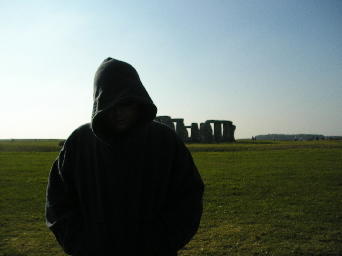
0 Comments:
Post a Comment
<< Home